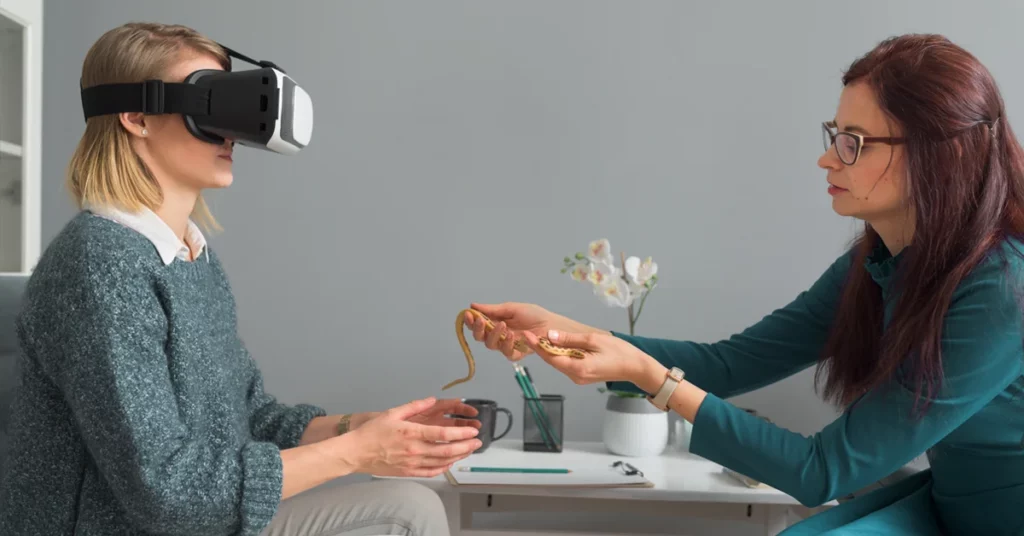Exposure and response prevention, or ERP, is a type of cognitive-behavioral therapy that has been proven to be an effective treatment for anxiety disorders. This guide will provide you with all the information you need to get started with ERP. We’ll discuss what exposure and response prevention is, how it works, and how you can start using it to overcome your anxiety.
Contents
What Is Exposure And Response Prevention?
 Exposure and Response Prevention (ERP) is a type of cognitive-behavioral therapy that is commonly used to treat anxiety disorders. Such as panic disorder, OCD, social anxiety disorder, and phobias. It involves gradually exposing the individual to their fears and anxieties in a safe and controlled environment. So that they can learn to respond differently to them.
Exposure and Response Prevention (ERP) is a type of cognitive-behavioral therapy that is commonly used to treat anxiety disorders. Such as panic disorder, OCD, social anxiety disorder, and phobias. It involves gradually exposing the individual to their fears and anxieties in a safe and controlled environment. So that they can learn to respond differently to them.
ERP focuses on identifying and understanding the triggers that cause anxiety and challenging negative thoughts. And gradually exposing the person to the feared stimulus or situation in order to decrease their fear. It is relatively easy to learn and can be used in both individual and group settings.
Studies have shown that ERP is an effective treatment for anxiety disorders, with long-term results being seen in most people who undergo it. Thus, if you are suffering from anxiety, this may be a viable option for you. With the help of a mental health professional, you can learn how to manage your fears and anxieties in a healthy way. So that you can live life to the fullest.
How Is Exposure Therapy Used For Anxiety?
Exposure therapy for anxiety is conducted in two steps – exposure and response prevention.
The first step, called “exposure” is when you confront your feared object or situation. For example, if you are afraid of public speaking, a therapist might have you start by just talking in front of one person and slowly build up to a larger group.
The second step is called “response prevention”. In this step, you practice maintaining exposure to the fear-producing situation without using any of your previously established coping strategies. This means if you used to avoid giving a speech by telling yourself that it’s not important. Or that people won’t think badly of you, during exposure therapy for anxiety, you will be expected to stay in the situation and resist your urges to escape or avoid it.
The goal of exposure therapy is not only for you to become less fearful and anxious. But also to decrease any avoidance behaviors that you may have developed as a result of your fear. Over time, with repeated exposures, your anxiety should lessen and eventually you’ll be able to confront the feared situation without feeling overwhelmed or anxious.
What Are The Benefits Of ERP For Anxiety?
 Exposure and response prevention for anxiety is an evidence-based approach to managing anxiety-related disorders. There are several benefits that come with using ERP, including:
Exposure and response prevention for anxiety is an evidence-based approach to managing anxiety-related disorders. There are several benefits that come with using ERP, including:
1. Increased Confidence and Self-Efficacy: ERP helps individuals to increase their confidence by challenging their anxious thoughts and replacing them with more realistic ones. Additionally, it also helps them build a sense of self-efficacy as they are able to recognize that they can manage their anxiety without avoidance or other forms of escape.
2. Improved Impact On Daily Life: By engaging in ERP, individuals are able to reduce their symptoms and thus improve the impact that anxiety has on their daily life. This could include things such as being able to go out into public places without fear, having better relationships with others, and performing better at work.
3. Improved Quality of Life: By managing their anxiety, individuals are able to enjoy a higher quality of life. This can include things such as being better able to participate in activities they enjoy, spending more time with family and friends, and having an overall better sense of well-being.
4. Reduced Anxiety Symptoms: ERP helps individuals to reduce their symptoms of anxiety, with some individuals even reporting complete symptom remission. This reduction can come in the form of decreased worry and rumination, decreased physical symptoms such as heart palpitations or shortness of breath, and improved sleep quality.
Overall, ERP is an effective approach for managing anxiety-related disorders. Through ERP, individuals can learn to challenge their anxious thoughts, gain a greater sense of self-efficacy, and improve the impact anxiety has on their daily life. Ultimately enjoy an improved quality of life.
How Is ERP Different From Traditional Therapies?
If you have anxiety and want to explore a different approach than traditional psychotherapy, you may want to consider ERP. It is a form of cognitive-behavioral therapy that focuses on helping individuals identify and modify their thoughts and behaviors related to their anxiety.
Unlike traditional therapies, ERP doesn’t focus on getting rid of the emotions associated with anxiety or understanding why the anxiety is happening. Instead, it focuses on changing the way individuals think and behave in order to reduce the intensity of their anxiety symptoms. It also helps individuals work through their fear and worries by gradually exposing them to feared situations or objects until they are no longer fearful.
ERP also differs from traditional psychotherapy in that it takes a structured approach. The therapist will work with the individual to identify their triggers and then develop an approach specific to that person’s anxiety. This approach often involves breaking down difficult tasks into smaller steps in order to make them more manageable.
Overall, ERP is a powerful tool for individuals dealing with anxiety and can help people learn how to manage their symptoms in a healthier way. With the help of an experienced therapist, individuals can learn to recognize their triggers and develop strategies for managing their anxiety in the future.
What Is The Success Rate Of ERP For Anxiety?
 Well, the exact success rate of ERP for anxiety is difficult to determine because different people respond differently to this type of treatment. Additionally, the success rate also depends on the severity and duration of the anxiety disorder being treated. Many studies have reported that ERP has a positive effect in reducing symptoms associated with various types of anxiety disorders.
Well, the exact success rate of ERP for anxiety is difficult to determine because different people respond differently to this type of treatment. Additionally, the success rate also depends on the severity and duration of the anxiety disorder being treated. Many studies have reported that ERP has a positive effect in reducing symptoms associated with various types of anxiety disorders.
In one study, it was reported that 80% of participants who underwent ERP saw a significant reduction in their symptoms of anxiety. Another study reported that after 12 weeks, 69% of participants showed improvement in symptoms.
In general, it has been found that people who complete the entire course of treatment tend to have better outcomes than those who do not finish it. Therefore, it is important to work with a mental health professional and follow their recommended course of treatment in order to maximize the potential of ERP for anxiety.
Can I Do ERP At Home?
People suffering from anxiety or even any type of mental illness are often unable to relax enough to be able to sleep or focus on work. ERP, or exposure and response prevention, is a type of therapy that can help those with anxiety, OCD, and other types of disorders. But can you do ERP at home?
The answer is yes and no. While it may seem like an appealing option to try to do exposure therapy on your own from the comfort of your home. But there are a few risks associated with this approach that should be considered.
The first thing to consider is whether or not you have the time and energy necessary to do ERP correctly. This type of treatment requires a significant commitment on your part. As it involves exposing yourself to the things you fear and facing them without engaging in the behavior or thought patterns that normally accompany those fears.
This means not only making sure you have the time to commit but also managing your own emotional reactions during such exposures. If you find it too difficult to do this on your own, then it may be best to seek professional help from a therapist who can provide support and guidance in this process.
Conclusion
To conclude, exposure and response prevention for anxiety is an effective treatment for those who suffer from it. It can help reduce symptoms and improve the quality of life for those who are affected by this condition. Exposure and response prevention therapy is a promising option for those looking to gain control over their anxiety and live a more fulfilled life.
With dedication, effort, and professional guidance, people can learn how to manage their anxiety and live a more fulfilling life. This approach can provide relief from the crippling symptoms of anxiety so that those who suffer from it can start taking steps to lead healthier, happier lives.
For more information and guidance, please contact MantraCare. OCD is a mental health disorder characterized by obsessions and compulsions. If you have any queries regarding Online OCD Counseling experienced therapists at MantraCare can help: Book a trial OCD therapy session


